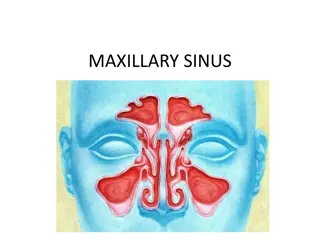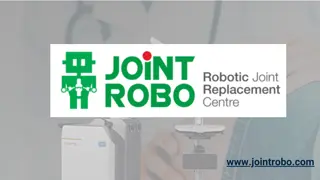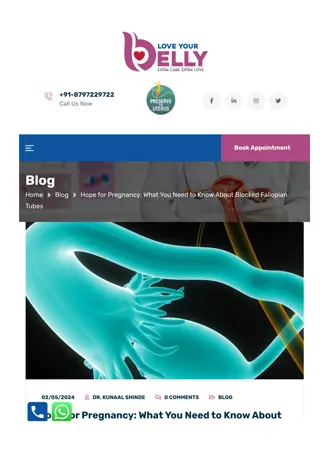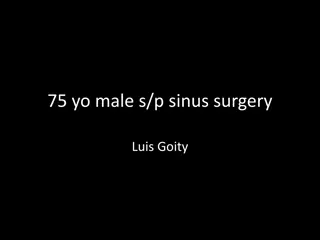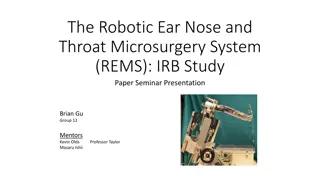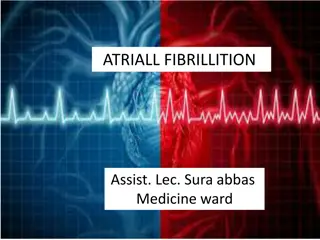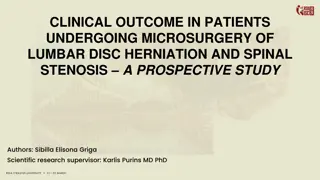Robotic ENT Microsurgery System: Addressing Sinus Surgery Challenges
This presentation discusses the Robotic ENT Microsurgery System (REMS) designed to address challenges faced in sinus surgery. It covers the system's calibration, IRB study, and tool holder design, highlighting the benefits of robotic assistance in overcoming critical structures, sensitive tissues, and the need for instrument repositioning. Subprojects focus on validating REMS for improving surgical skills compared to conventional methods. Follow along as progress is made in identifying anatomies of interest, developing training modules, and recruiting participants for the study.
Download Presentation

Please find below an Image/Link to download the presentation.
The content on the website is provided AS IS for your information and personal use only. It may not be sold, licensed, or shared on other websites without obtaining consent from the author.If you encounter any issues during the download, it is possible that the publisher has removed the file from their server.
You are allowed to download the files provided on this website for personal or commercial use, subject to the condition that they are used lawfully. All files are the property of their respective owners.
The content on the website is provided AS IS for your information and personal use only. It may not be sold, licensed, or shared on other websites without obtaining consent from the author.
E N D
Presentation Transcript
The Robotic ENT Microsurgery System (REMS): Calibration and IRB Study, and Tool Holder Design Checkpoint Presentation CIS II Spring 2015: Brian Gu, Barbara Kim, Kurt Lee
Background - Sinus Surgery Traditionally performed "open" - entering through facial incision. Often associated with scarring and other complications. Endoscopic sinus surgery is minimally invasive, in favor.
Background - Sinus Surgery Challenges: -Many critical structures are in the surgical area (brain, eye orbit, carotid artery). These are closely intertwined with the sinuses. -Need to repeatedly remove operative instruments (cleaning, check CT position as tracking is poor) -Sinus tissue easily damaged, sensitive in general. Can occlude endoscopic view.
REMS - Robotic ENT Microsurgery System Robotic system designed with the goal of addressing surgical challenges - specifically those encountered in OHNS (of which sinus surgery is a subset) Assists in manipulation - eliminates unwanted movement from surgeon (i.e. hand tremor) Assists in navigation - combines positional tracking information with registered pre-operative images to avoid sensitive anatomy ("barrier zones")
Subproject 1: REMS Sinus Validation Study Primary goal is to determine if robotic surgical assistance with REMS improves surgical skill compared to conventional surgery. Protocol: 20 students randomly separated into two groups 10 will "learn sinus surgery" with the REMS 10 with current learning protocol An expert group will perform the task to gather data on how REMS affects professionals.
Subproject 1 Progress Identified anatomies of interest for study: Eustacian tube, carotid artery, optic nerve, middle turbinate Created basic storyboard for training module Recruited 35% of undergraduates needed for study
Subproject 1 Next Steps Finish training module Establish criteria for accuracy Collect Data
Subproject 2: Additional Calibration Tool holder not perfectly stiff Leads to minor deflection of the tool when used admittance style Error currently not accounted for in robot's kinematics has a force sensor however! Use computer vision approach to track tool tip compare position from computer vision system to position/force in the REMS Calibrate using AX=XB method Do this for many different poses and forces Fit polynomial to account for error
Subproject 2 Progress Created and coded tracking system that tracks green ball in pixel coordinates of cameras Currently working on creating a function to go from pixel coordinates to 3D world coordinates
Subproject 2 Next Steps Create piece to rigidly attach green ball to tool Calibrate green ball to tool tip Gather deflection data Fit deflection data to polynomial
Subproject 3: Modified Tool Holder Current tool holder allows for free rotation of tool Does not track this rotation Not a problem for straight tools Cannot accurately track tip of burred/angled tool tips Two options: Motorized holder or free rotation with tracking Must be accurate to a few degrees Must leave small footprint (does not interfere with hand movements of doctor)
Subproject 3 Next Steps Meet with Kevin to discuss feasibility of ideas today Begin rapid prototyping
Old Deliverables Minimum Completion of Completion of Completion of one of the three two of the three all three sub-projects* sub-projects sub-projects Expected Maximum Either IRB study IRB study *presentable prototype OR calibration AND calibration of the tool holder
Updated Deliverables Minimum Completion of calibration Expected Completion of calibration Maximum Completion of calibration 5 subjects done the study 10 subjects done the study all 20 subjects done the study At least one presentable prototype At least one presentable prototype
Updated Dependencies Meetings with Dr. Ishii, full correspondence 20 undergraduates with proper training for study Cadaver head for REMS study
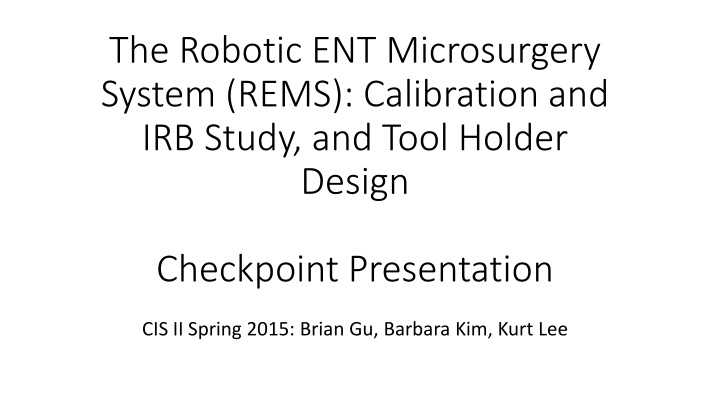

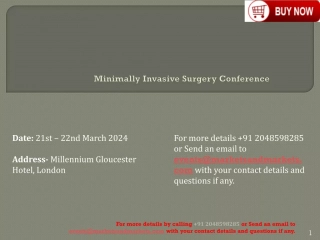
![❤[READ]❤ Robotic Exploration of the Solar System: Part I: The Golden Age 1957-19](/thumb/21623/read-robotic-exploration-of-the-solar-system-part-i-the-golden-age-1957-19.jpg)



